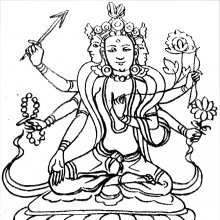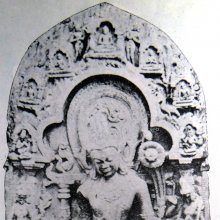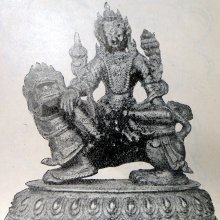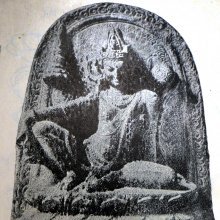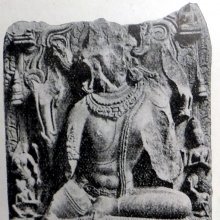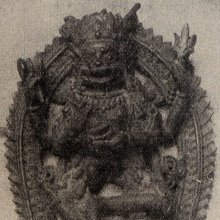Ardhaparyanka, Ardhaparyaṅka, Ardha-paryanka: 6 definitions
Introduction:
Ardhaparyanka means something in Buddhism, Pali, Jainism, Prakrit, Hinduism, Sanskrit. If you want to know the exact meaning, history, etymology or English translation of this term then check out the descriptions on this page. Add your comment or reference to a book if you want to contribute to this summary article.
Images (photo gallery)
(+26 more images available)
In Buddhism
Tibetan Buddhism (Vajrayana or tantric Buddhism)
Source: OSU Press: Cakrasamvara SamadhiArdhaparyaṅka (अर्धपर्यङ्क) is the name of a dancing-position and is used to describe Vajravārāhī, according to the Saṃvaramaṇḍala of Abhayākaragupta’s Niṣpannayogāvalī, p. 45 and n. 145; (Cf. Cakrasaṃvaratantra, Gray, David B., 2007).—Vajravārāhī appears both with Cakrasaṃvara, and on her own, both as Vajravārāhī and Vajrayoginī. On her own as Vajravārāhī she appears dancing in half paryaṅka, (ardhaparyaṅka-nṛtyā) the most common posture for Ḍākinīs. Paryaṅka is a common sitting posture for meditation, where the bent knees point forward, feet point back, with hamstrings resting on the calves. Dancing in half paryaṅka, is a standing posture, where one leg is lifted in ardhaparyaṅka, and the other is on the ground, indicating a joyous and passionate Buddha nature. [...]

Tibetan Buddhism includes schools such as Nyingma, Kadampa, Kagyu and Gelug. Their primary canon of literature is divided in two broad categories: The Kangyur, which consists of Buddha’s words, and the Tengyur, which includes commentaries from various sources. Esotericism and tantra techniques (vajrayāna) are collected indepently.
In Jainism
General definition (in Jainism)
Source: archive.org: The Jaina IconographyArdhaparyaṅka (अर्धपर्यङ्क) or Ardhaparyaṅkāsana refers to one of the various āsanas (postures) commonly depcited in Jain iconography.—While the Paryaṅkāsana is sitting on the hams, the Ardhaparyaṅkāsana is half sitting on hams. In the latter posture, one leg hangs angularly, the other remains folded. The same Āsana is also called Paryaṅkāsana-māna which has been defined as the position in which the Yogī lessens the weight of his body by one-third. This posture is not common to the images of the Jinas. We get, however, instances of this in the case of the Yakṣas and Yakṣiṇīs. The figures of Cakreśvarī from Gandhawal in Gwalior State and Nirvāṇī Yakṣiṇī explored by me are represented in this posture.
Source: The University of Sydney: A study of the Twelve ReflectionsArdhaparyaṅka (अर्धपर्यङ्क) refers to “sitting half cross-legged”, according to the 11th century Jñānārṇava, a treatise on Jain Yoga in roughly 2200 Sanskrit verses composed by Śubhacandra.—Accordingly, “On a flat piece of wood or stone, on the ground or on sandy soil, the wise [person] should adopt a stable posture for the accomplishment of absorption. Thus, sitting cross-legged, sitting half cross-legged (ardhaparyaṅka), thunderbolt, hero posture and the previously mentioned pleasant and lotus [postures] as well as abandonment of the body is highly thought of. [...]”.

Jainism is an Indian religion of Dharma whose doctrine revolves around harmlessness (ahimsa) towards every living being. The two major branches (Digambara and Svetambara) of Jainism stimulate self-control (or, shramana, ‘self-reliance’) and spiritual development through a path of peace for the soul to progess to the ultimate goal.
Languages of India and abroad
Sanskrit dictionary
Source: Cologne Digital Sanskrit Dictionaries: Edgerton Buddhist Hybrid Sanskrit DictionaryArdhaparyaṅka (अर्धपर्यङ्क).—(m.; = Pali aḍḍha-pallaṅka), half- paryaṅka position (with only one leg bent under): Lalitavistara 155.1 (°kaṃ kṛtvā).
Source: Cologne Digital Sanskrit Dictionaries: Monier-Williams Sanskrit-English DictionaryArdhaparyaṅka (अर्धपर्यङ्क):—[=ardha-paryaṅka] m. sitting half (id est. partly) upon the hams (a particular posture practised in meditation; cf. paryaṅka), [Lalita-vistara]
[Sanskrit to German]
Sanskrit, also spelled संस्कृतम् (saṃskṛtam), is an ancient language of India commonly seen as the grandmother of the Indo-European language family (even English!). Closely allied with Prakrit and Pali, Sanskrit is more exhaustive in both grammar and terms and has the most extensive collection of literature in the world, greatly surpassing its sister-languages Greek and Latin.
See also (Relevant definitions)
Partial matches: Ardha, Paryanka.
Starts with: Ardhaparyankasana.
Full-text (+46): Ardhaparyankin, Rupini, Paryanka, Vasyavajravarahi, Buddhakapala, Vajravarahi, Vajracarcika, Uddiyanakurukulla, Varadatara, Mokshasana, Ajaya, Shubhamekhala, Vajrahuntika, Varada, Subhaga, Bhimadarshana, Shubha, Ostaraki, Shadbhujasitatara, Jaya.
Relevant text
Search found 3 books and stories containing Ardhaparyanka, Ardhaparyaṅka, Ardha-paryanka, Ardha-paryaṅka; (plurals include: Ardhaparyankas, Ardhaparyaṅkas, paryankas, paryaṅkas). You can also click to the full overview containing English textual excerpts. Below are direct links for the most relevant articles:
The Indian Buddhist Iconography (by Benoytosh Bhattachacharyya)
Figure 171 - Emanations of Amoghasiddhi: Ṣaḍbhuja-Sitatārā
Figure 126-127 - Emanations of Akṣobhya: Buddhakapāla
Jainism in Odisha (Orissa) (by Ashis Ranjan Sahoo)
Jaina Antiquities in Pratapanagari (Cuttack) < [Chapter 3: Survey of Jaina Antiquities in Odisha]
Stupas in Orissa (Study) (by Meenakshi Chauley)
